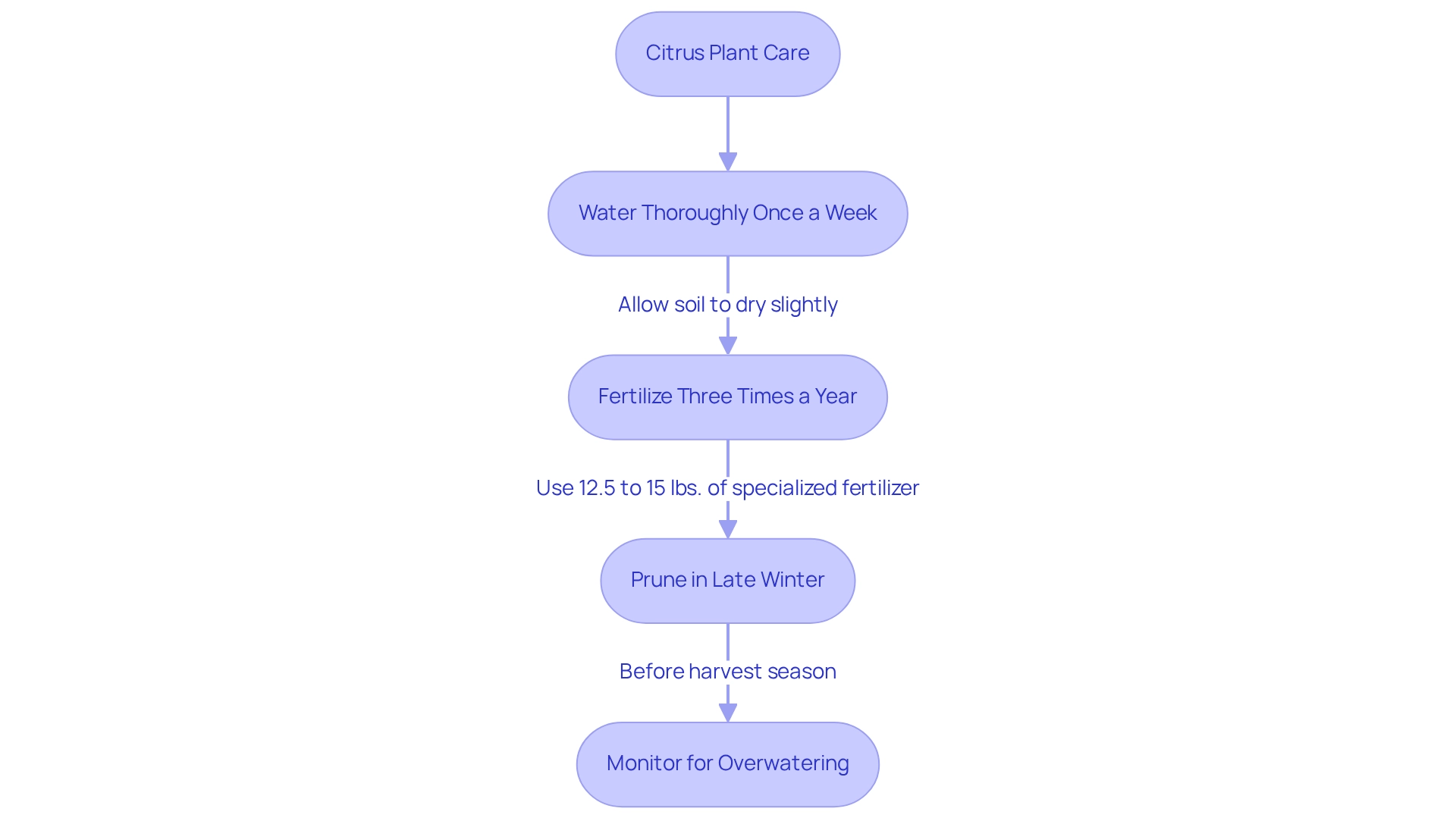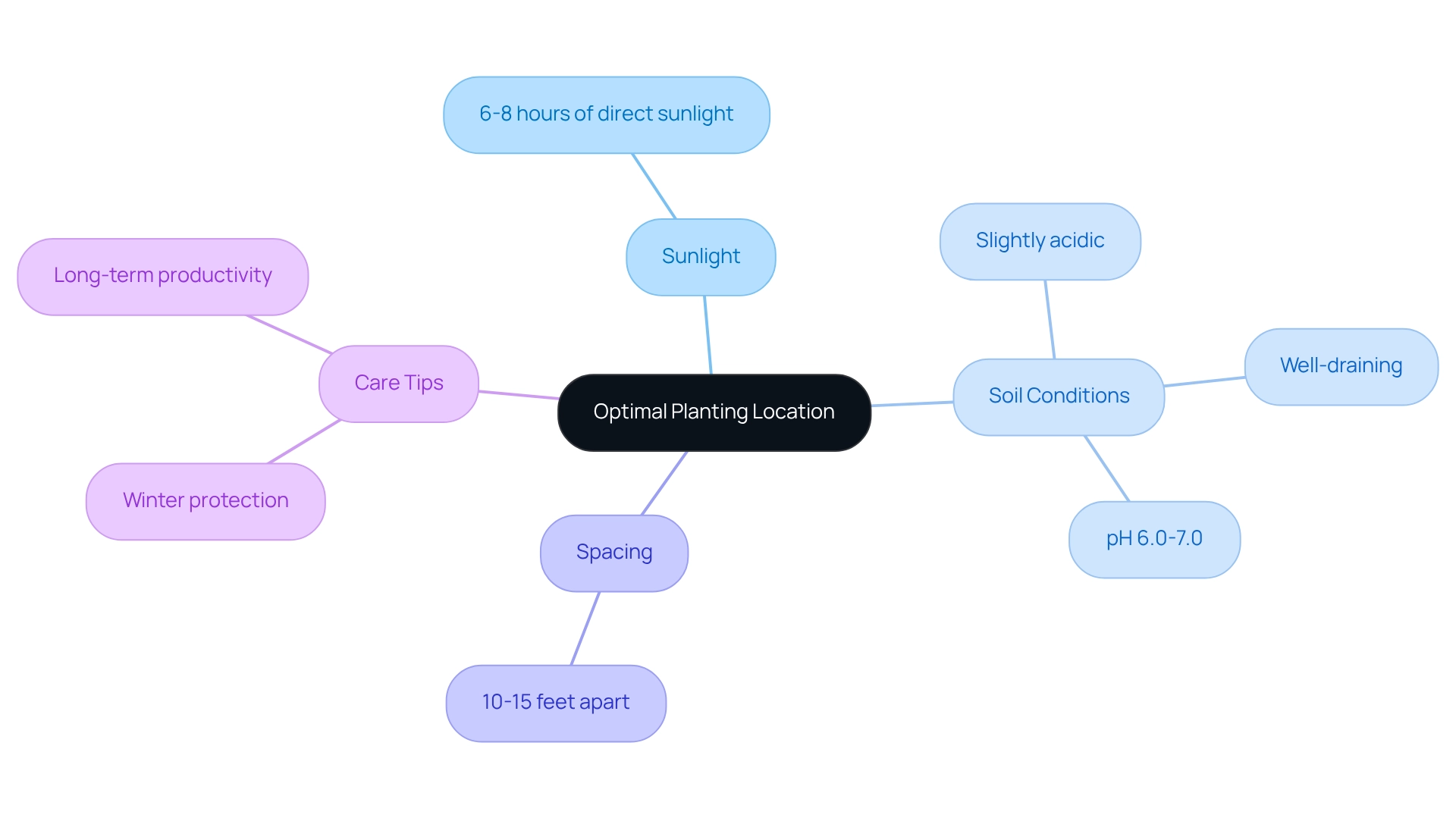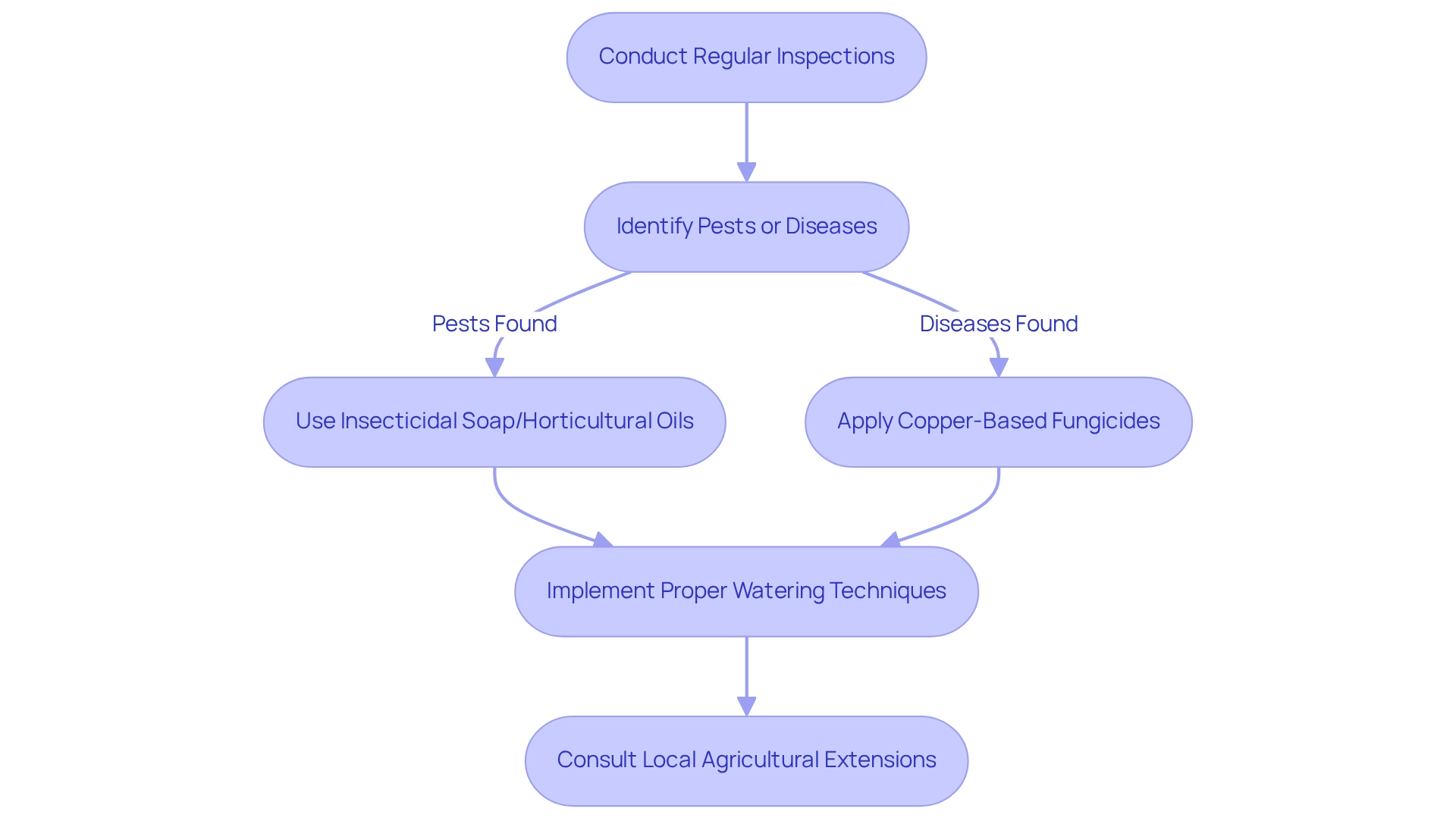To help your citrus plant thrive, it's essential to
select a location that receives at least 6 to 8 hours of direct sunlight each day. This sunlight is vital for boosting fruit production and maintaining the plant's overall health. The soil should be well-draining and slightly acidic, ideally with a pH range of 6.0 to 7.0. It's wise to steer clear of heavy clay or overly sandy soils, as these can hinder root development. When planting, ensure you space your citrus plants adequately from structures and other plants—about 10 to 15 feet apart—to reduce shading and competition for nutrients. As horticulturist Kiersten Rankel beautifully puts it, "With the appropriate conditions and meticulous planning, your citrus plants can thrive magnificently."
Additionally, don’t forget to protect your container plants during the winter months. Bringing them indoors or providing frost protection can make a significant difference. Remember, citrus plants can produce fruit from the current season up to 2 years after grafting, so creating the right planting conditions is crucial for ongoing productivity. A case study titled 'Harvesting Citrus Fruits' highlights that these fruits can be harvested over an extended period without sacrificing quality, enhancing their appeal for fresh consumption, juicing, and culinary uses.
As you embark on this gardening adventure, imagine the joy of watching your citrus plants flourish and bear fruit, bringing a touch of sunshine to your home. What steps can you take today to ensure their success?
🌱 Browse Fruit Trees or our Fast Growing Trees if you’re planning a mini citrus grove.
Protect container plants during colder months, especially if you're in cooler regions. And remember—fruit can appear as early as the first year after grafting. Everglades Farm provides expert-grown citrus trees that ship directly from Florida, with care instructions included.
2. Implement Comprehensive Care Practices
Consistent maintenance is essential for the vitality of your citrus plant. We understand that gardening can be challenging, but with a little care, your plants can thrive. Water your plant thoroughly once a week during the growing season, allowing the soil to dry out slightly between waterings to prevent root rot. This practice is crucial, as the Valencia orange tree flourishes with consistent moisture levels.
Fertilization should occur three times a year using a specialized citrus fertilizer, with application rates typically around 12.5 to 15 lbs. per large plant. This ensures a nutrient-rich environment that promotes robust growth. It's important to choose a fertilizer with 46% nitrogen to support healthy development. Pruning is best performed in late winter to remove any dead or crossing branches, enhancing air circulation and sunlight penetration, which are vital for healthy growth. As Felipe Benavides wisely advises, "If you decide to prune, be sure to do it before the harvest season."
Have you ever wondered if your plant is getting enough water? Incorporating techniques such as the finger test or weight test can help determine the optimal watering times, ensuring your plant receives adequate hydration without the risk of overwatering. Furthermore, using instruments such as soil moisture meters can offer valuable insights into your plant's moisture needs.
Common pitfalls include overwatering or improper fertilization, which can hinder growth and vitality. By adhering to these thorough care methods, you can greatly enhance the health and output of
your Valencia orange tree, ensuring a plentiful yield and a flourishing garden. Remember, with patience and love, your gardening journey can be a rewarding experience.

To sum up, consistent care leads to vibrant fruit. Here’s how to keep your tree thriving:
-
Watering: Weekly during the growing season; let the soil dry slightly in between.
-
Fertilizing: Use a citrus-specific fertilizer (46% nitrogen) three times a year. Explore options in our Citrus Tree Collection.
-
Pruning: Trim dead or crossing branches in late winter to improve airflow and light exposure.
Pro tip: Did you know overwatering and poor fertilization are the most common citrus pitfalls? Avoid them with a simple finger test or moisture meter.
🍊 Want smaller citrus varieties too? Consider the Sugar Belle® Dwarf Tree or Kishu Mandarin Tree for compact spaces
3. Manage Pests and Diseases Effectively
To nurture the health of your Valencia orange tree, it's essential to regularly inspect for common pests like aphids, spider mites, and citrus thrips. When you spot these invaders, prompt treatment with insecticidal soap or horticultural oils can effectively manage these infestations. Additionally, keep an eye out for conditions such as citrus canker and root rot, as these can significantly impact your tree's vitality. By adopting effective cultural practices—like appropriate watering techniques and avoiding overhead irrigation—you can greatly reduce the risk of infection. If you notice any symptoms of illness, don’t hesitate to reach out to local agricultural extensions for tailored treatment options.
Statistics show that citrus canker is a prevalent issue in many orchards, highlighting the need for proactive management strategies. Using copper-containing fungicides has proven effective in managing greasy spot affliction in citrus, offering another resource for control. Expert insights suggest that integrated pest management (IPM) approaches are vital for effectively controlling pests and diseases. For example, a case study on pest management in the Valencia orange tree revealed the success of using biological controls alongside chemical treatments, leading to a remarkable decrease in pest populations and improved tree health.
Moreover, the citrus industry is currently facing challenges, including declining acreage and production. As Stephen Devadoss pointed out, "The decline in orange and grapefruit acreages should be of significant concern to growers, processors, and policy makers." This underscores the importance of effective pest and illness management. By adopting these practices, you can contribute to the sustainability of your citrus trees and enjoy a bountiful harvest.
- Conduct regular inspections for pests and diseases.
- Use insecticidal soap or horticultural oils for pest control.
- Apply copper-based fungicides for greasy spot disease.
- Implement proper watering techniques to prevent root rot.
- Consult local agricultural extensions for tailored advice.
❄️ 10 Tips for Enhancing Valencia Orange Cold Hardiness
4. Master the Harvesting Techniques
Harvesting the fruits of a Valencia orange tree can be a rewarding experience, especially when you know the right time to pick them. Look for fruits that display full color and yield slightly to gentle pressure, typically from March to October. When it’s time to remove the fruit, gently twist the citrus until the stem comes apart—this method helps prevent damage to your beloved plant. If you're ever unsure about ripeness, don’t hesitate to taste a sample; the fruit should be sweet and juicy. By harvesting carefully, not only do you enhance the flavor, but you also encourage increased fruit production in the seasons to come.
Expert recommendations highlight that visual cues, like color and firmness, serve as critical indicators of ripeness. Did you know that acceptance scores for the fruit have remained high (≥4) for 10-14 weeks under optimal conditions? This reinforces the
importance of harvesting at just the right moment to maintain quality. Effective harvesting methods, as shown in various case studies, emphasize the connection between proper techniques and the overall quality of the fruit. This ensures that home gardeners, like you, can enjoy the best possible yield from your Valencia orange tree. As Hart notes, the oligopsony power of orange processors and buyers underscores the significance of quality in harvesting practices. It’s essential for us as gardeners to prioritize these techniques. Remember to avoid common pitfalls, such as pulling fruit instead of twisting it off, to protect the health of your trees and maximize your yield.
🍊 Start Growing Your Own Valencia Orange Tree
Nurturing a thriving Valencia orange tree is a rewarding journey that encompasses various essential practices. It all begins with selecting the perfect planting location—one that basks in sunlight and boasts well-draining, slightly acidic soil. This foundation is key to fostering a healthy tree. As we consistently water, fertilize appropriately, and prune at the right times, we ensure robust growth, allowing our trees to remain productive for years to come.
Moreover, proactive management of pests and diseases is vital for maintaining our tree’s vitality. Regular inspections and effective treatments can help us mitigate potential threats, paving the way for a healthier harvest. Have you ever wondered how to recognize the perfect moment to harvest? Understanding the nuances of ripeness and employing gentle detachment methods can significantly enhance the quality of our fruit, ensuring that each orange is sweet and juicy.
Ultimately, nurturing a Valencia orange tree transcends mere labor; it’s about cultivating a deeper connection with nature and savoring the fruits of our efforts. By embracing these comprehensive practices, we can look forward to a bountiful harvest, contribute to the sustainability of our citrus trees, and relish the sweet rewards of our labor. The journey of cultivating these vibrant trees is filled with learning and satisfaction, culminating in the joy of sharing delicious, homegrown oranges with loved ones.
Cultivate Your Own Sweet Harvest Today!
Frequently Asked Questions
How much sunlight do citrus plants need to thrive?
Citrus plants need at least 6 to 8 hours of direct sunlight each day to boost fruit production and maintain overall health.
What type of soil is best for planting citrus plants?
The ideal soil for citrus plants is well-draining and slightly acidic, with a pH range of 6.0 to 7.0. It's important to avoid heavy clay or overly sandy soils.
How far apart should citrus plants be spaced when planting?
Citrus plants should be spaced about 10 to 15 feet apart from structures and other plants to reduce shading and competition for nutrients.
What precautions should be taken for container citrus plants during winter?
Container citrus plants should be brought indoors or provided with frost protection during the winter months to ensure their survival and health.
How long can citrus plants produce fruit after grafting?
Citrus plants can produce fruit from the current season up to 2 years after grafting.






